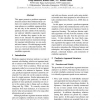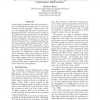141
click to vote
KDD
2012
ACM
13 years 3 months ago
2012
ACM
Many data are modeled as tensors, or multi dimensional arrays. Examples include the predicates (subject, verb, object) in knowledge bases, hyperlinks and anchor texts in the Web g...
119
Voted
ACL
2011
14 years 4 months ago
2011
Identifying domain-dependent opinion words is a key problem in opinion mining and has been studied by several researchers. However, existing work has been focused on adjectives an...
101
Voted
ACL
2011
14 years 4 months ago
2011
Resolving coordination ambiguity is a classic hard problem. This paper looks at coordination disambiguation in complex noun phrases (NPs). Parsers trained on the Penn Treebank are...
127
Voted
ACL
2011
14 years 4 months ago
2011
Resolving polysemy and synonymy is required for high-quality information extraction. We present ConceptResolver, a component for the Never-Ending Language Learner (NELL) (Carlson ...
114
Voted
ACL
2009
14 years 10 months ago
2009
This paper presents a predicate-argument structure analysis that simultaneously conducts zero-anaphora resolution. By adding noun phrases as candidate arguments that are not only ...
113
click to vote
CORR
1999
Springer
15 years 11 days ago
1999
Springer
Corpus-based grammar induction generally relies on hand-parsed training data to learn the structure of the language. Unfortunately, the cost of building large annotated corpora is...
98
Voted
COLING
1994
15 years 2 months ago
1994
This paper presents a heuristic method that uses information in the Japanese text along with knowledge of English countability and number stored in transfer dictionaries to determ...
109
Voted
EACL
1993
ACL Anthology
15 years 2 months ago
1993
ACL Anthology
In this paper, we describe a method for structural noun phrase disambiguation which mainly relies on the examination of the text corpus under analysis and doesn't need to int...
100
Voted
TREC
2003
15 years 2 months ago
2003
In TREC 2003, the Database and Information System Lab (DBIS) at University of Illinois at Chicago (UIC) participate in the robust track, which is a traditional ad hoc retrieval ta...
93
Voted
ANLP
2000
15 years 2 months ago
2000
The performance of machine learning algorithms can be improved by combining the output of different systems. In this paper we apply this idea to the recognition of noun phrases. W...







